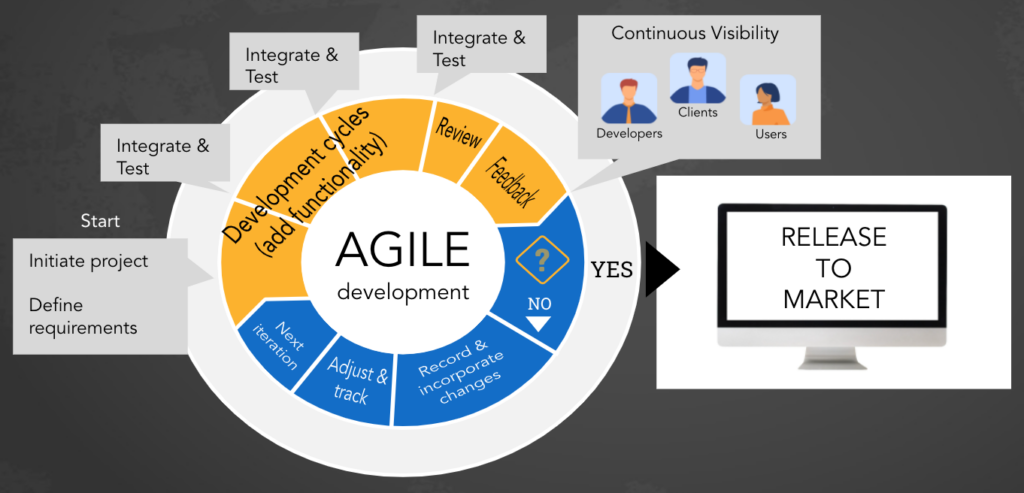More than just a method used to create software, Agile is ideal, a philosophy that helps optimize and streamline the product development process.
An agile ceremony (also known as a Scrum ceremony) is a way to obtain quick feedback on a development project, which, in turn, improves both the final product itself and the overall culture within Agile teams. What’s more, the final result provides increased value to the final customer.
Below, we define agile ceremonies and how they help Scrum teams be the best possible version of themselves.
To learn more via video, watch below. Otherwise, skip ahead.
What is an Agile Ceremony?
Agile ceremonies are meetings where a development team comes together to keep each other updated on their project’s details. At the same time, other Scrum ceremonies, such as the sprint retrospective, helps the scrum team look back on their work and find ways of improving for future sprints.
A team’s success depends on its ability to approach each project from a logical and strategic point of view while maintaining flawless collaborative efforts throughout the project.

Agile ceremonies simplify communication across the team, thereby improving the development process and the corresponding product end result that users experience.
Scrum Masters lead Scrum ceremonies. These leaders direct the meeting and ensure the team achieves the sprint goal. At each meeting, the Scrum Master, product owner, and development team are present and engage in discourse that helps to better the overall output of the Agile team.

Credits: Youtube
There are four distinct types of agile ceremonies. Let’s take a closer look at each one.
The Sprint Planning Meeting
A sprint is a timed period where a team works to complete a predetermined amount of work. The sprint planning meeting (also known as sprint planning) takes place at the beginning of a sprint.
Led by a Scrum Master, this ceremony is where the Scrum team discusses the project in its entirety and also provides updates on individual testosterone enanthate online milestones and estimated deadlines. Once the sprint planning meeting is over, the product owner then updates the product backlog to reflect any changes in original milestones and each one’s estimated deadline.
The items in the product backlog are the topic of discussion during sprint planning. These ceremonies are when the entire team estimates the effort required for each item.
Think of sprint planning as an essential step that takes place before the next sprint.
The Daily Stand-Up
Unlike sprint planning, a daily stand-up ceremony happens once per day and is kept short and sweet, no more than fifteen minutes.
Also known as a daily scrum, the Scrum Master is the one who leads these short ceremonies. These Scrum ceremonies get the entire Scrum team caught up to speed in just a quick meeting.
Each team member briefs others on what they’ve completed the previous day, what they’re working on today, and whether or not there are any obstacles that affect the team.
The idea behind the daily stand-up is to keep a Scrum team accountable for their work while also ensuring that everyone is on the same page.
The Iteration Review or Sprint Review Meeting
Also known as a sprint review, an iteration review happens at the end of each sprint once a milestone is complete.
The iteration or sprint review is led by a Scrum master and involves the development team, the product owner, and external project stakeholders.
A sprint review aims to demonstrate the team’s work up to a certain point. A Scrum team comes together to celebrate its achievements and get immediate feedback from the product owner and stakeholders.
The Scrum Master must ensure the iteration review lasts only 60 minutes for every week of iteration. In other words, a 3-hour iteration or sprint review meeting occurs after a three-week sprint.
The Sprint Retrospective
Sprint retrospectives are the final Scrum ceremony that makes up the Agile framework.
Unlike a sprint review, a retrospective or sprint retrospective provides ongoing guidance and takes place at the end of each iteration. The idea here is to provide Agile teams with a tool for continuous improvement.
The Scrum Master and development team are the ones who champion sprint retrospectives. That said, the product owner must also be present. The goal is to provide feedback on what worked during the iteration and what needs improvements for future iterations.
During a retrospective, when a team member brings up a complaint about something that hindered the iteration, it’s time for everyone to band together and find creative solutions to a problem. That way, that problem won’t happen again.
On the other hand, when discussing positives, the team must focus on those items to improve their work in the future.
Understanding Agile and Scrum Ceremonies
Agile ceremonies are all about providing the team with immediate feedback and helping everyone find ways to make the final product and the culture within an organization that much better.
Unlike traditional team meetings, a Scrum team’s agile ceremonies have distinct purposes depending on the current stage of the project at hand.
Be sure to review the definition and advantages of each of these four types of Scrum ceremonies to find out how you and your Scrum team stand to benefit from them in your weekly work schedules.
